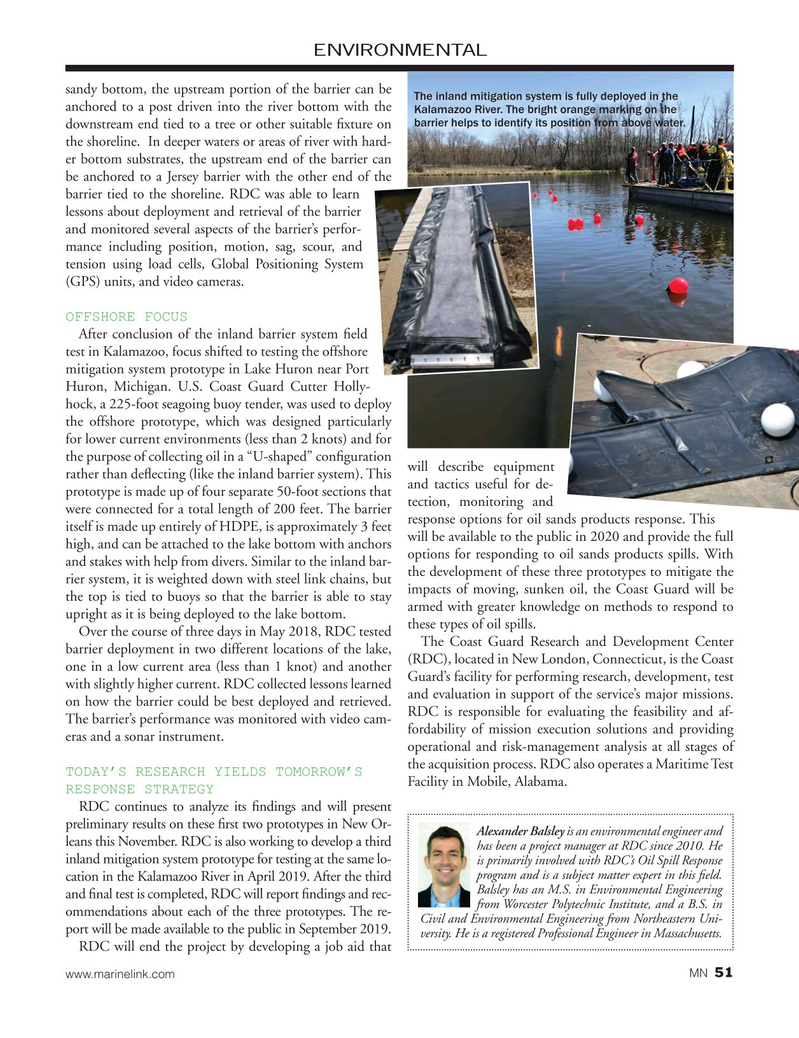
Page 51: of Marine News Magazine (September 2018)
Offshore Annual
Read this page in Pdf, Flash or Html5 edition of September 2018 Marine News Magazine
ENVIRONMENTAL sandy bottom, the upstream portion of the barrier can be
The inland mitigation system is fully deployed in the anchored to a post driven into the river bottom with the
Kalamazoo River. The bright orange marking on the barrier helps to identify its position from above water.
downstream end tied to a tree or other suitable ? xture on the shoreline. In deeper waters or areas of river with hard- er bottom substrates, the upstream end of the barrier can be anchored to a Jersey barrier with the other end of the barrier tied to the shoreline. RDC was able to learn lessons about deployment and retrieval of the barrier and monitored several aspects of the barrier’s perfor- mance including position, motion, sag, scour, and tension using load cells, Global Positioning System (GPS) units, and video cameras.
OFFSHORE FOCUS
After conclusion of the inland barrier system ? eld test in Kalamazoo, focus shifted to testing the offshore mitigation system prototype in Lake Huron near Port
Huron, Michigan. U.S. Coast Guard Cutter Holly- hock, a 225-foot seagoing buoy tender, was used to deploy the offshore prototype, which was designed particularly for lower current environments (less than 2 knots) and for the purpose of collecting oil in a “U-shaped” con? guration will describe equipment rather than de? ecting (like the inland barrier system). This and tactics useful for de- prototype is made up of four separate 50-foot sections that were connected for a total length of 200 feet. The barrier tection, monitoring and response options for oil sands products response. This itself is made up entirely of HDPE, is approximately 3 feet will be available to the public in 2020 and provide the full high, and can be attached to the lake bottom with anchors options for responding to oil sands products spills. With and stakes with help from divers. Similar to the inland bar- rier system, it is weighted down with steel link chains, but the development of these three prototypes to mitigate the the top is tied to buoys so that the barrier is able to stay impacts of moving, sunken oil, the Coast Guard will be armed with greater knowledge on methods to respond to upright as it is being deployed to the lake bottom.
these types of oil spills.
Over the course of three days in May 2018, RDC tested
The Coast Guard Research and Development Center barrier deployment in two different locations of the lake, one in a low current area (less than 1 knot) and another (RDC), located in New London, Connecticut, is the Coast
Guard’s facility for performing research, development, test with slightly higher current. RDC collected lessons learned on how the barrier could be best deployed and retrieved. and evaluation in support of the service’s major missions.
RDC is responsible for evaluating the feasibility and af-
The barrier’s performance was monitored with video cam- fordability of mission execution solutions and providing eras and a sonar instrument.
operational and risk-management analysis at all stages of the acquisition process. RDC also operates a Maritime Test
TODAY’S RESEARCH YIELDS TOMORROW’S
Facility in Mobile, Alabama.
RESPONSE STRATEGY
RDC continues to analyze its ? ndings and will present preliminary results on these ? rst two prototypes in New Or-
Alexander Balsley is an environmental engineer and leans this November. RDC is also working to develop a third has been a project manager at RDC since 2010. He inland mitigation system prototype for testing at the same lo- is primarily involved with RDC’s Oil Spill Response program and is a subject matter expert in this

 50
50

 52
52
